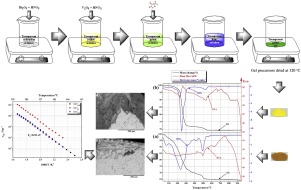当前位置:
X-MOL 学术
›
Thermochim. Acta
›
论文详情
Our official English website, www.x-mol.net, welcomes your feedback! (Note: you will need to create a separate account there.)
Aqueous sol-gel synthesis, thermal analysis, characterization and electrical properties of V2O5 doped Bi2O3 system
Thermochimica Acta ( IF 3.5 ) Pub Date : 2020-03-01 , DOI: 10.1016/j.tca.2020.178511 Austėja Diktanaitė , Giedrė Gaidamavičienė , Edvardas Kazakevičius , Algimantas Kežionis , Artūras Žalga
Thermochimica Acta ( IF 3.5 ) Pub Date : 2020-03-01 , DOI: 10.1016/j.tca.2020.178511 Austėja Diktanaitė , Giedrė Gaidamavičienė , Edvardas Kazakevičius , Algimantas Kežionis , Artūras Žalga

|
Abstract The aqueous sol-gel synthesis technique was successfully applied for the preparation of Bi–V–O tartrate gel precursors in the sol-gel process using tartaric acid as a ligand. By combining different characterization techniques, the influence of the complexing agent amount to both the elemental composition and surface morphology of the final ceramic was estimated. According to the decomposition mechanism of Bi–V–O tartrate gel precursors, it is clear that the coordination ability of tartaric acid significantly affects by its concentration in the water solution during the gelation process. Additionally, it was also showed that thermal analysis is a powerful method that enables the observation of several important processes, which are closely related to the decomposition of volatile compounds, phase transitions and stability of intermediates. Besides, it was demonstrated that X-ray diffraction and scanning electron microscopy strongly supplement the conclusions made from the results of thermal analysis. However, the content of elements in the gel precursor and ceramic powders measured by elemental analysis revealed that a molar ratio of bismuth and vanadium has a tendency to vary either by increasing the heat-treatment temperature or by decreasing the amount of tartaric acid. Finally, after the evaluation of obtained data the impedance analysis of 5Bi2O3·V2O5 ceramic was performed, which showed promising total conductivity values with 0.93 eV of activation energy in the range of investigated temperature.
中文翻译:

V2O5 掺杂 Bi2O3 体系的水溶胶-凝胶合成、热分析、表征和电学性质
摘要 在以酒石酸为配体的溶胶-凝胶工艺中,水溶胶-凝胶合成技术成功地应用于制备Bi-V-O酒石酸凝胶前体。通过结合不同的表征技术,估计了络合剂用量对最终陶瓷的元素组成和表面形态的影响。根据Bi-V-O酒石酸凝胶前驱体的分解机理,很明显,在凝胶化过程中,酒石酸在水溶液中的浓度显着影响其配位能力。此外,还表明热分析是一种强大的方法,可以观察与挥发性化合物分解、相变和中间体稳定性密切相关的几个重要过程。此外,还证明 X 射线衍射和扫描电子显微镜有力地补充了从热分析结果中得出的结论。然而,通过元素分析测量的凝胶前体和陶瓷粉末中的元素含量表明,铋和钒的摩尔比有随热处理温度升高或酒石酸含量降低而变化的趋势。最后,在对获得的数据进行评估后,对 5Bi2O3·V2O5 陶瓷进行了阻抗分析,结果表明在研究温度范围内具有 0.93 eV 的活化能的总电导率值很有希望。通过元素分析测量的凝胶前体和陶瓷粉末中的元素含量表明,铋和钒的摩尔比有变化的趋势,要么通过提高热处理温度,要么通过减少酒石酸的量。最后,在对获得的数据进行评估后,对 5Bi2O3·V2O5 陶瓷进行了阻抗分析,结果表明在研究温度范围内具有 0.93 eV 的活化能的总电导率值很有希望。通过元素分析测量的凝胶前体和陶瓷粉末中的元素含量表明,铋和钒的摩尔比有变化的趋势,要么通过提高热处理温度,要么通过减少酒石酸的量。最后,在对获得的数据进行评估后,对 5Bi2O3·V2O5 陶瓷进行了阻抗分析,结果表明在研究温度范围内具有 0.93 eV 的活化能的总电导率值很有希望。
更新日期:2020-03-01
中文翻译:

V2O5 掺杂 Bi2O3 体系的水溶胶-凝胶合成、热分析、表征和电学性质
摘要 在以酒石酸为配体的溶胶-凝胶工艺中,水溶胶-凝胶合成技术成功地应用于制备Bi-V-O酒石酸凝胶前体。通过结合不同的表征技术,估计了络合剂用量对最终陶瓷的元素组成和表面形态的影响。根据Bi-V-O酒石酸凝胶前驱体的分解机理,很明显,在凝胶化过程中,酒石酸在水溶液中的浓度显着影响其配位能力。此外,还表明热分析是一种强大的方法,可以观察与挥发性化合物分解、相变和中间体稳定性密切相关的几个重要过程。此外,还证明 X 射线衍射和扫描电子显微镜有力地补充了从热分析结果中得出的结论。然而,通过元素分析测量的凝胶前体和陶瓷粉末中的元素含量表明,铋和钒的摩尔比有随热处理温度升高或酒石酸含量降低而变化的趋势。最后,在对获得的数据进行评估后,对 5Bi2O3·V2O5 陶瓷进行了阻抗分析,结果表明在研究温度范围内具有 0.93 eV 的活化能的总电导率值很有希望。通过元素分析测量的凝胶前体和陶瓷粉末中的元素含量表明,铋和钒的摩尔比有变化的趋势,要么通过提高热处理温度,要么通过减少酒石酸的量。最后,在对获得的数据进行评估后,对 5Bi2O3·V2O5 陶瓷进行了阻抗分析,结果表明在研究温度范围内具有 0.93 eV 的活化能的总电导率值很有希望。通过元素分析测量的凝胶前体和陶瓷粉末中的元素含量表明,铋和钒的摩尔比有变化的趋势,要么通过提高热处理温度,要么通过减少酒石酸的量。最后,在对获得的数据进行评估后,对 5Bi2O3·V2O5 陶瓷进行了阻抗分析,结果表明在研究温度范围内具有 0.93 eV 的活化能的总电导率值很有希望。



























 京公网安备 11010802027423号
京公网安备 11010802027423号